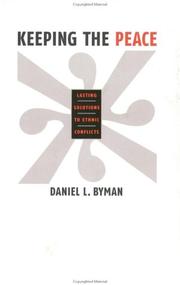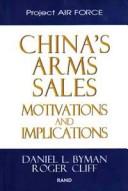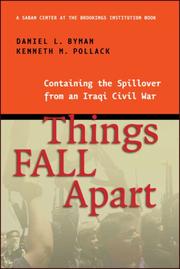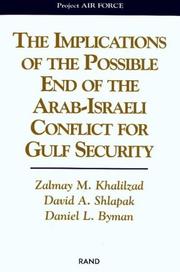| Listing 1 - 10 of 11 | << page >> |
Sort by
|
Book
ISBN: 9780190217266 9780190217259 019021726X 0190217251 Year: 2015 Publisher: Oxford Oxford University Press
Abstract | Keywords | Export | Availability | Bookmark
 Loading...
Loading...Choose an application
- Reference Manager
- EndNote
- RefWorks (Direct export to RefWorks)
On the morning of September 11, 2001, the entire world was introduced to Al Qaeda and its enigmatic leader, Osama bin Laden. But the organization that changed the face of terrorism forever and unleashed a whirlwind of counterterrorism activity and two major wars had been on the scene long before that eventful morning. In Al Qaeda, the Islamic State, and the Global Jihadist Movement: What Everyone Needs to Know, Daniel L. Byman, an eminent scholar of Middle East terrorism and international security who served on the 9/11 Commission, provides a sharp and concise overview of Al Qaeda, from its humble origins in the mountains of Afghanistan to the present, explaining its perseverance and adaptation since 9/11 and the limits of U.S. and allied counterterrorism efforts. The organization that would come to be known as Al Qaeda traces its roots to the anti-Soviet jihad in Afghanistan in the 1980s. Founded as the Soviets withdrew from Afghanistan, Al Qaeda achieved a degree of international notoriety with a series of spectacular attacks in the 1990s; however, it was the dramatic assaults on the World Trade Center and the Pentagon on 9/11 that truly launched Al Qaeda onto the global stage. The attacks endowed the organization with world-historical importance and provoked an overwhelming counterattack by the United States and other western countries. Within a year of 9/11, the core of Al Qaeda had been chased out of Afghanistan and into a variety of refuges across the Muslim world. Splinter groups and franchised offshoots were active in the 2000s in countries like Pakistan, Iraq, and Yemen, but by early 2011, after more than a decade of relentless counterterrorism efforts by the United States and other Western military and intelligence services, most felt that Al Qaeda's moment had passed. With the death of Osama bin Laden in May of that year, many predicted that Al Qaeda was in its death throes. Shockingly, Al Qaeda has staged a remarkable comeback in the last few years. In almost every conflict in the Muslim world, from portions of the Xanjing region in northwest China to the African subcontinent, Al Qaeda franchises or like-minded groups have played a role. Al Qaeda's extreme Salafist ideology continues to appeal to radicalized Sunni Muslims throughout the world, and it has successfully altered its organizational structure so that it can both weather America's enduring full-spectrum assault and tailor its message to specific audiences
Polemology --- Islamic fundamentalism --- Terrorism --- Violence --- Intégrisme islamique --- Terrorisme --- Qaida (Organization) --- IS (Organization) --- ViolenceQaida (Organization) --- Intégrisme islamique --- Terrorism - Middle East --- Islamic fundamentalism - Middle East --- Violence - Middle East --- the anti-Soviet jihad --- the jihadist movement --- the United States --- Bin Laden --- Al Qaeda --- Sudan --- Egypt --- the Taliban --- 9-11 --- attacks and plots --- the 1998 embassy attacks --- the 9-11 attacks --- strategy and tactics --- suicide bombing --- lone wolves --- Al Qaeda training camp --- nuclear weapons --- salafi-jihadism --- Salafism --- Wahhabism --- Deobandism --- Ahl-e Hadith --- the Muslim Brotherhood --- killing civilians --- propaganda --- organization and recruitment --- Ayman al-Zawahiri --- the role of war --- the role of the internet --- money --- the 2003 Iraq war --- Iran and the Shi'a --- Saudi Arabia --- Pakistan --- Israel --- the Arab Spring --- Al Qaeda affiliates --- the Arabian Peninsula --- the Islamic Maghreb --- Al Shabaab --- Jabhat al-Nusra --- the Islamic State --- Abu Bakr al-Baghdadi --- the Syrian government --- the Khorasan Group --- counterterrorism --- diplomacy --- the legal system --- military tribunals --- Guantanamo --- post 9-11 legal measures --- rendition --- US military force --- drones --- air strikes --- collecting intelligence --- allied governments --- radicalization --- Europe --- Islamitische Staat

ISBN: 0801868041 Year: 2002 Publisher: Baltimore, Md Johns Hopkins University Press
Abstract | Keywords | Export | Availability | Bookmark
 Loading...
Loading...Choose an application
- Reference Manager
- EndNote
- RefWorks (Direct export to RefWorks)
Sociology of minorities --- Polemology --- Ethnic conflict --- World politics --- Nationalism --- Political aspects. --- Middle East --- Europe --- Politics and government --- Ethnic relations. --- 1989 --- -Nationalism --- 20th century --- Ethnic relations --- Political aspects
Book
ISBN: 0190252383 1283098180 9786613098184 0199830452 9780199830459 9781283098182 9780190252380 9780195391824 0195391829 0199831742 9780199931781 Year: 2011 Publisher: Oxford Oxford University Press
Abstract | Keywords | Export | Availability | Bookmark
 Loading...
Loading...Choose an application
- Reference Manager
- EndNote
- RefWorks (Direct export to RefWorks)
In the sixty-plus years of the Jewish state's existence, Israeli governments have exhausted almost every option in defending their country against terror attacks. Israel has survived and even thrived--but both its citizens and its Arab neighbors have paid dearly. In A High Price , Daniel Byman breaks down the dual myths of Israeli omnipotence and--conversely--ineptitude in fighting terror, offering instead a nuanced, definitive historical account of the state's bold but often failed efforts to fight terrorist groups. The product of painstaking research and countless interviews, the book chroni
Arab-Israeli conflict. --- Terrorism --Israel --Prevention. --- Terrorism --Israel. --- Terrorism --- Arab-Israeli conflict --- Social Welfare & Social Work --- Social Sciences --- Criminology, Penology & Juvenile Delinquency --- Prevention --- Israel-Arab conflicts --- Israel-Palestine conflict --- Israeli-Arab conflict --- Israeli-Palestinian conflict --- Jewish-Arab relations --- Palestine-Israel conflict --- Palestine problem (1948- ) --- Palestinian-Israeli conflict --- Palestinian Arabs --- History --- Prevention. --- Polemology --- Israel
Book
ISBN: 0197537626 0197537634 0197537642 9780197537633 9780197537619 0197537618 Year: 2022 Publisher: New York, N.Y. Oxford University Press
Abstract | Keywords | Export | Availability | Bookmark
 Loading...
Loading...Choose an application
- Reference Manager
- EndNote
- RefWorks (Direct export to RefWorks)
'Spreading Hate' offers a history of the modern white power movement, describing key moments in its evolution since the end of World War Two. Daniel Byman focuses particular attention on how the threat has changed in recent decades, examining how social media is changing the threat, the weaknesses of the groups, and how counterterrorism has shaped the movement as a whole. Each chapter uses an example, such as the Christchurch mosque shooter Brenton Tarrant or the British white hate band Skrewdriver, as a way of introducing broader analytic themes
White supremacy movements --- Terrorism --- Hate crimes --- History. --- Supremacist movements, White --- Supremacy movements, White --- White supremacist movements --- Social movements --- White nationalism --- Skinheads --- Bias crimes --- Bias-related crimes --- Hate-motivated crimes --- Hate offenses --- Crime --- Hate crimes. --- Prevention. --- Prevention --- White supremacy movements - History --- Terrorism - History --- Hate crimes - History --- Criminology. Victimology --- Polemology

ISBN: 083302776X 0833043544 0585384134 9780585384139 9780833043542 9780833027764 Year: 1999 Publisher: Santa Monica Rand
Abstract | Keywords | Export | Availability | Bookmark
 Loading...
Loading...Choose an application
- Reference Manager
- EndNote
- RefWorks (Direct export to RefWorks)
S07/0350 --- S10/0520 --- S09/0610 --- S10/0685 --- China: Army and police force--Army, navy and air force: since 1949 --- China: Economics, industry and commerce--Industry: since 1949 --- China: Foreign relations and world politics--China and USA: since 1949 --- China: Economics, industry and commerce--US-China economic relations --- Arms transfers --- Business & Economics --- Industries --- China --- United States --- Military policy. --- Military relations --- Arms sales --- Arms traffic --- Foreign military sales --- Military sales --- Munitions --- Sale of military equipment --- U.S.A. --- Jungtinės Amerikos valstybės --- Soedinennye Shtaty Si︠e︡vernoĭ Ameriki --- Soedinennye Shtaty Severnoĭ Ameriki --- Si︠e︡vero-Amerikanskīe Soedinennye Shtaty --- Severo-Amerikanskie Soedinennye Shtaty --- Zlucheni Derz︠h︡avy --- USA --- US --- Arhab --- Ar. ha-B. --- Artsot ha-Berit --- ولايات المتحدة الامريكية --- Wilāyāt al-Muttaḥidah al-Amirīkīyah --- ABSh --- Amerika Birlăshmish Shtatlary --- ABŞ --- Amerika Birlăşmi Ştatları --- Forente stater --- Spojené staty americké --- Severo-Amerikanskie Shtaty --- Sjedinjene Američke Države --- Zʹi︠e︡dnani Derz︠h︡avy Ameryky --- Amerikai Egyesült Államok --- Yhdysvallat --- Verenigde Staten --- Egyesült Államok --- Hiwsisayin Amerikayi Miatsʻeal Tērutʻiwnkʻ --- Estados Unidos de América --- United States of America --- Fareyniḳṭe Shṭaṭn --- Artzois Ha'bris --- Estados Unidos da América do Norte --- SShA --- Soedinennye Shtaty Ameriki --- VSA --- États-Unis d'Amérique --- Vereinigte Staaten von Amerika --- Stati Uniti d'America --- Estados Unidos --- EE.UU. --- Stany Zjednoczone --- ĒPA --- Amerika Qūrama Shtattary --- Amerika Qŭshma Shtatlari --- SAD --- Saharat ʻAmērikā --- Hēnomenai Politeiai Amerikēs --- ZSA --- Mei-kuo --- Meiguo --- Mei guo --- ZDA --- Združene države Amerike --- U.S. --- America (Republic) --- Amirika Carékat --- Verenigde State van Amerika --- VS --- ولايات المتحدة --- Wilāyāt al-Muttaḥidah --- ولايات المتّحدة الأمريكيّة --- Wilāyāt al-Muttaḥidah al-Amrīkīyah --- Estatos Unitos --- Estatos Unitos d'America --- Ètats-Unis d'Amèrica --- Estaos Xuníos d'América --- Estaos Xuníos --- Tetã peteĩ reko Amérikagua --- Istadus Unidus --- Amerika Birlăşmiş Ştatları --- Amerika ka Kelenyalen Jamanaw --- Bí-kok --- Amerika Qushma Shtattary --- AQSh --- Злучаныя Штаты Амерыкі --- Zluchanyi︠a︡ Shtaty Ameryki --- Yunaeted Stet blong Amerika --- Yunaeted Stet --- Vaeinigte Staatn --- Vaeinigte Staatn vo Amerika --- Stadoù-Unanet Amerika --- Sŭedineni amerikanski shtati --- САЩ --- SASht --- Съединените щати --- Sŭedinenite shtati --- Америка (Republic) --- Amerika (Republic) --- Estats Units d'Amèrica --- Америкӑри Пӗрлешӳллӗ Штатсем --- Amerikări Pĕrleshu̇llĕ Shtatsem --- Stati Uniti --- SUA (Stati Uniti d'America) --- Unol Daleithiau America --- Unol Daleithiau --- Amerikas Forenede Stater --- Vereinigte Staaten --- Wááshindoon Bikéyah Ałhidadiidzooígíí --- Zjadnośone staty Ameriki --- Ameerika Ühendriigid --- Ηνωμένες Πολιτείες της Αμερικής --- Hēnōmenes Politeies tēs Amerikēs --- Η.Π.Α. --- Ē.P.A. --- Usono --- Unuiĝintaj Ŝtatoj de Ameriko --- Американь Вейтьсэндявкс Штаттнэ --- Amerikanʹ Veĭtʹsėndi︠a︡vks Shtattnė --- Ameriketako Estatu Batuak --- Feriene Steaten --- Feriene Steaten fan Amearika --- FS --- Stâts Unîts di Americhe --- Stâts Unîts --- Stáit Aontaithe Mheiriceá --- Steatyn Unnaneysit America --- Steatyn Unnaneysit --- S.U.A. --- Na Stàitean Aonaichte --- NSA --- Mî-koet --- 미국 --- Miguk --- Amerikayi Miatsʻyal Nahangner --- Miatsʻyal Nahangner --- Cina --- Kinë --- Cathay --- Chinese National Government --- Chung-kuo kuo min cheng fu --- Republic of China (1912-1949) --- Kuo min cheng fu (China : 1912-1949) --- Chung-hua min kuo (1912-1949) --- Kina (China) --- National Government (1912-1949) --- China (Republic : 1912-1949) --- People's Republic of China --- Chinese People's Republic --- Chung-hua jen min kung ho kuo --- Central People's Government of Communist China --- Chung yang jen min cheng fu --- Chung-hua chung yang jen min kung ho kuo --- Central Government of the People's Republic of China --- Zhonghua Renmin Gongheguo --- Zhong hua ren min gong he guo --- Kitaĭskai︠a︡ Narodnai︠a︡ Respublika --- Činská lidová republika --- RRT --- Republik Rakjat Tiongkok --- KNR --- Kytaĭsʹka Narodna Respublika --- Jumhūriyat al-Ṣīn al-Shaʻbīyah --- RRC --- Kitaĭ --- Kínai Népköztársaság --- Chūka Jinmin Kyōwakoku --- Erets Sin --- Sin --- Sāthāranarat Prachāchon Čhīn --- P.R. China --- PR China --- Chung-kuo --- Zhongguo --- Zhonghuaminguo (1912-1949) --- Zhong guo --- Chine --- République Populaire de Chine --- República Popular China --- Catay --- VR China --- VRChina --- 中國 --- Jhongguó --- Bu̇gu̇de Nayiramdaxu Dundadu Arad Ulus --- Bu̇gu̇de Nayiramdaqu Dumdadu Arad Ulus --- Bu̇gd Naĭramdakh Dundad Ard Uls --- Khi︠a︡tad --- Kitad --- Dumdadu Ulus --- Dumdad Uls --- Думдад Улс --- Kitajska --- 中国 --- 中华人民共和国 --- International trade --- Arms race --- Defense industries --- Military assistance --- China (Republic : 1949- ) --- Американь Вейтьсэндявкс Штаттнэ --- Spojené obce severoamerické --- PRC --- P.R.C. --- BNKhAU --- БНХАУ --- États-Unis --- É.-U. --- ÉU

ISBN: 9780815713791 0815713797 Year: 2007 Publisher: Washington, D.C. Brookings Institution
Abstract | Keywords | Export | Availability | Bookmark
 Loading...
Loading...Choose an application
- Reference Manager
- EndNote
- RefWorks (Direct export to RefWorks)
Polemology --- Iraq --- United States of America
Book
ISBN: 9780815703419 0815703414 Year: 2009 Publisher: Washington, D.C. Brookings Institution Press
Abstract | Keywords | Export | Availability | Bookmark
 Loading...
Loading...Choose an application
- Reference Manager
- EndNote
- RefWorks (Direct export to RefWorks)
"Crafting a new policy toward Iran is a complicated, uncertain, and perilous challenge. Since it is an extremely complex society, with an opaque political system, it is no wonder that the United States has not yet figured out the puzzle that is Iran. With the clock ticking on Iran's pursuit of nuclear capabilities, solving this puzzle is more urgent than ever." "In Which Path to Persia? a group of experts with the Saban Center for Middle East Policy at Brookings lays out the courses of action available to the United States. What are the benefits and drawbacks of airstrikes? Can engagement be successful? Is regime change possible? In answering such questions, the authors do not argue for one approach over another. Instead, they present the details of the policies so that readers can understand the complexity of the challenge and decide for themselves which course the United States should take."--BOOK JACKET
International relations. Foreign policy --- Iran --- United States --- Etats-Unis --- Foreign relations --- Relations extérieures --- IranForeign relations --- Relations extérieures --- United States - Foreign relations - Iran --- Iran - Foreign relations - United States --- United States of America

ISBN: 0833024698 Year: 1997 Publisher: Santa Monica Rand
Abstract | Keywords | Export | Availability | Bookmark
 Loading...
Loading...Choose an application
- Reference Manager
- EndNote
- RefWorks (Direct export to RefWorks)
Arab-Israeli conflict --- National security --- United States. --- Foreign service
Book

ISBN: 159875260X Year: 2001 Publisher: Santa Monica : RAND Corporation,
Abstract | Keywords | Export | Availability | Bookmark
 Loading...
Loading...Choose an application
- Reference Manager
- EndNote
- RefWorks (Direct export to RefWorks)
This report presents a framework for intelligence analysts to use to think systematically about the potential for the rise of a peer competitor to the United States. Using exploratory techniques, the pathways of the various proto-peer and hegemon interactions are modelled.
Book

ISBN: 9780815722267 Year: 2011 Publisher: Washington (D.C.) Brookings Institution Press
Abstract | Keywords | Export | Availability | Bookmark
 Loading...
Loading...Choose an application
- Reference Manager
- EndNote
- RefWorks (Direct export to RefWorks)
| Listing 1 - 10 of 11 | << page >> |
Sort by
|

 Search
Search Feedback
Feedback About UniCat
About UniCat  Help
Help News
News